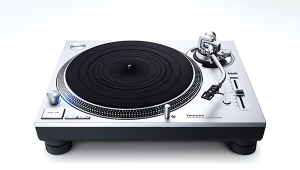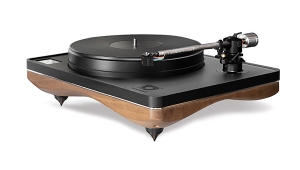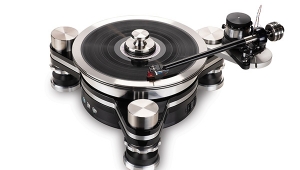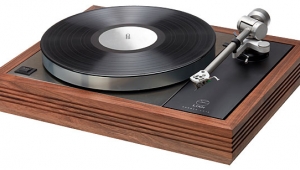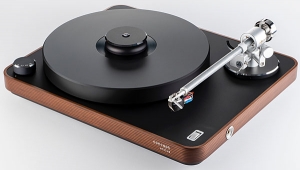| Columns Retired Columns & Blogs |
VPI HR-X turntable & JMW12.6 tonearm
VPI Industries' TNT turntable and JMW Memorial tonearm have evolved through several iterations over the last two decades. Some changes have been large, such as the deletion of the three-pulley subchassis and the introduction of the SDS motor controller. Others have been invisible—a change in bearing or spindle material, for example, or the way the bearing attaches to the plinth. And, as longtime Stereophile readers know, I've been upgrading and evolving along with VPI, most recently reporting on the TNT V-HR turntable (Stereophile, December 2001).
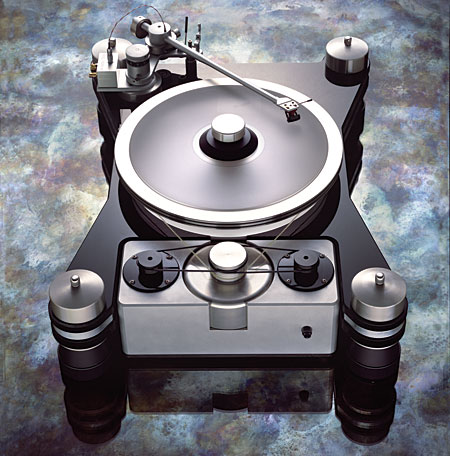
But about the time I was expecting the next iteration, designer Harry Weisfeld threw me a curve by unveiling a completely new turntable design, the HR-X. First shown in prototype form at Stereophile's Home Entertainment 2002 show in New York City, the HR-X is a stunning, milled-from-aluminum showcase of everything Weisfeld has learned from designing turntables for the past 25 years.
Nuts & bolts
Although the HR-X is a clean-slate design, it was obviously informed by the TNT. There are four corner towers with internal pneumatic bladders, a huge platter belt-driven by an outboard motor and flywheel, and a JMW tonearm mounted directly to a massive plinth. Beyond that basic configuration, however, everything is different—rethought, improved, optimized, and executed to the highest standard possible. It's immediately obvious that even VPI's workmanship and cosmetics have been raised to new levels: the TNT was well-built and solid; the HR-X is striking and sumptuous.
Weisfeld began by changing the plinth material, first to the prototype's aluminum, and finally to the HR-X's three-layer laminate of acrylic-aluminum-acrylic. The laminate was found to damp vibrations better than solid slabs of either material alone, and Weisfeld was trying to eliminate the TNT's upper-bass/lower-midrange emphasis and slight softening of dynamic transients. "A lot of people thought the warmth was due to the acrylic chassis," he told me, "but not so. When we did the Scout, we discovered that the biggest contributor wasn't the chassis but the bearing."
Weisfeld explained that the biggest challenge in developing the Aries Scout (reviewed by Art Dudley in February 2003) was coming up with a suitable bearing assembly that could be produced within the available cost constraints ($1600 retail, including a JMW 9 tonearm). "We tried to work through it with our machinist, but he got frustrated and said, 'Get out of here and let me figure it out.' What he came up with was the inverted bearing assembly. When we got the package together, it sounded great! And what's more, we noticed that it didn't seem to have the warmth of our other 'tables." The discovery led to the new bearing design, first for the Scout, then the HR-X.
The inverted bearing is quite simple, though executed to exacting specifications. The bottom element consists of a ball of hardened steel (Rc 60) press-fitted into the top of a similarly hardened steel shaft, which is then solidly attached to the plinth with a single, large nut that tightens from beneath. The mating assembly, press-fitted into the underside of the platter, consists of a stainless-steel boss that houses a graphite-impregnated brass sleeve and a 50/50 Teflon-Delrin pad that mates with the lower assembly's steel ball. Weisfeld has found that simplicity—ie, fewer material interfaces—almost always results in better sound.
The next major change was the replacement of the outboard motor and flywheel with a single, integrated unit housing the flywheel and two smaller motors. The reason for a flywheel is straightforward: add rotational inertia for speed stability, but not in the platter, where the mass would place even more stringent demands on the bearing assembly. "The TNT, like every turntable I've heard, sounds a lot better with a flywheel. The problem was generating enough torque to get it started. We tried a lot of things, but the two-motor assembly worked the best."
The last component was the perimeter clamping ring, something that Weisfeld had been thinking of for decades. "This was the hardest machining job of all. I always wanted to do it, but no one could make it for me. Finally, I found a guy who builds doors for biological level-four rooms, and he can do it." The clamping ring also enabled Weisfeld to lighten the JMW arm a bit and remove the armwand's internal damping.
This isn't the end of the story—the HR-X will continue to evolve. There's already a new tower assembly that replaces the pneumatic bladder ("Firestone couldn't make them consistently enough") with a racquetball, and a tonearm/terminal-block combo wired with Nordost Valhalla cable. When I asked Weisfeld what was next, he said that he's working on ways to reduce the number of parts in the JMW's mounting and VTA adjustment assembly by 60% to increase its rigidity and eliminate a few more interfaces.
Some of the HR-X's elements have already trickled down to other models. The TNT-6 turntable uses the new bearing and motor assembly, a platter/clamping-ring combination is available for the other models, and the new Aries will have a three-layer plinth similar to the HR-X's.
Music
The HR-X was simple to set up and use, and, other than a leaky pneumatic bladder (since replaced), it performed flawlessly. The new motor/flywheel assembly worked beautifully, bringing the platter up to speed quickly and precisely. Ditto the circumferential clamp, which was simple to operate, and by far the best record-holding and -flattening system I've ever used. And for nervous types, it eliminates any concern about a vacuum hold-down system leaching out the vinyl's plasticizers.
Like the TNT, the HR-X really likes to be level, and any time spent optimizing cartridge setup is well spent. After I'd gotten the setup as close as possible with my Wally Tools, I took about two days to fine-tune my latest Lyra Titan-I cartridge. Like all VPI turntables, the HR-X has no antiskating compensation. Harry Weisfeld believes that there are too many variables to allow true fine-tuning of antiskating, so it's best to just twist the leads to apply a bit of force and leave it at that. I'll duck the debate and just say that twisting the HR-X's leads seemed to work just fine—and after a decade of using TNTs, my records don't seem any the worse for wear. I did try Wally's antiskating system during my auditioning, and although it was more precisely "tuneable" than VPI's twist-the-leads method, I didn't find it sounded any better or any more consistent.
TNTs have always had wonderfully quiet, black backgrounds, but the HR-X bettered my TNT V-HR by a substantial margin in this regard. With acoustic recordings, my listening room was replaced by a deep, almost endless background silence. It wasn't an unnatural, "turned-off" digital silence, but a coherent, silent texture that let me sense the performance or recording space around me. And when instruments or voices entered, they didn't just appear but developed naturally, energizing the space around them.
The Mady Mesplé–Charles Burles performance of Delibes' Lakmé (LP, Seraphim SIC-6082), one of my "Records To Die For," was a tour de force on the HR-X. No recording, no system, anywhere or anytime, has re-created a performance as naturally as the combo of HR-X and Lyra Titan did with this set. The performers had a solidity and dimensionality that put them "in" the room—or, rather, in the soundstage that had replaced my room. Everything about the HR-X's playback of this recording was uncanny and just right, from the tiniest detail or ambience cue to the sizes and spacing of the images and orchestra, and how they matched the listener's perspective.
Along with the deeper, blacker background—due, I presume, to better speed stability and a lower noise floor—came a noticeable improvement in the resolution of low-level and inner detail. TNTs are no slouches in this regard, so while the HR-X's improved performance was always noticeable, it wasn't particularly overt. During Lakmé, for example, I didn't register a wealth of new details, or previously unheard whispers and noises. Instead, everything about the performers and the space seemed sharper, clearer, and more three-dimensionally solid. Edges, whether they defined a person or a feature of the hall, were better defined than I recall being the case with my TNT V-HR.
- Log in or register to post comments
